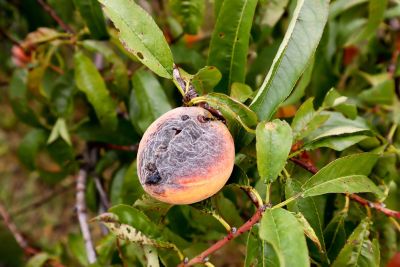Is My Peach Tree Sick?
It’s important to watch for peach disease symptoms so you can treat your tree as quickly as possible. Peach tree diseases and fungus are common problems and can affect nearly any part of the tree. If your tree seems to be ailing or your fruit doesn’t look right, read on.
Common Peach Diseases
Here’s a quick rundown of some of the most common types of peach tree diseases: Bacterial Spot – Bacterial spot attacks both fruits and leaves. It produces purple-red spots with white centers on leaf surfaces that may fall away, leaving a shot-hole appearance in the leaf. Bacterial spot on the fruit starts with small dark spots on the skin, gradually spreading and sinking more deeply into the flesh. Fortunately, damage on fruits can be cut out and the fruit still eaten, even if they don’t look good enough for the produce market. Good cultural care is critical for preventing bacterial spot. A few partially resistant peach varieties are available, including Candor, Norman, Winblo, and Southern Pearl. Brown Rot – Brown rot is arguably the most serious disease of peach fruits. Brown rot fungus can destroy flower blossoms and shoots, beginning at bloom time. You can recognize it by the small, gummy cankers that appear on infected tissues. It will spread to your healthy green fruits when the wet weather sets in. Infected fruit develop a small, brown spot that expands and eventually covers the whole fruit. The fruit will ultimately shrivel and dry up, or “mummify,” on the tree. You’ll need to remove and burn all mummies from the tree to break the brown rot life cycle. Consult with your local garden center, an agricultural extension agent, or a certified arborist about applying a fungicide to ward off the fungus for the next harvest. Peach Leaf Curl – Peach leaf curl can appear in the spring. You may see thick, puckered, or distorted leaves with a red-purple cast begin to develop instead of your normal, healthy leaves. Eventually, leaves affected by leaf curl will grow a mat of gray spores, dry out, and drop, weakening the tree itself. Once this first round of leaves has dropped, however, you probably won’t see much of this condition for the rest of the season. A single spray of lime, sulfur, or copper fungicide all over the tree each winter should prevent future problems with peach leaf curl. Peach Scab – Peach scab, like bacterial spot, is for the most part just an aesthetic problem. Small, dark spots and cracks appear on the surface, but may be so numerous they grow together into large patches. Shoots and twigs might develop oval lesions with brown centers and raised purple margins. It’s important to increase the air circulation in the tree’s canopy by pruning it, severely if necessary. After the petals fall, you can spray with a protectant fungicide, like wettable sulfur. Treat the tree with spray five times, at 7 to 14 day intervals after the petals have fallen. Peach Yellows – Peach yellows is a common problem in trees that aren’t already on a spray program and is transported by leafhoppers. Leaves and shoots may emerge in a deformed manner creating clusters, or witches brooms. Fruits from trees suffering from peach yellows will ripen prematurely, and are likely to be bitter and of poor quality. Peach yellows may only affect part of the tree, however, there is no cure for this problem – once the symptoms are obvious, removing the tree is the only option. Peach trees can be vulnerable but, with good, attentive peach tree care, you’ll have perfect peaches and healthy trees.
